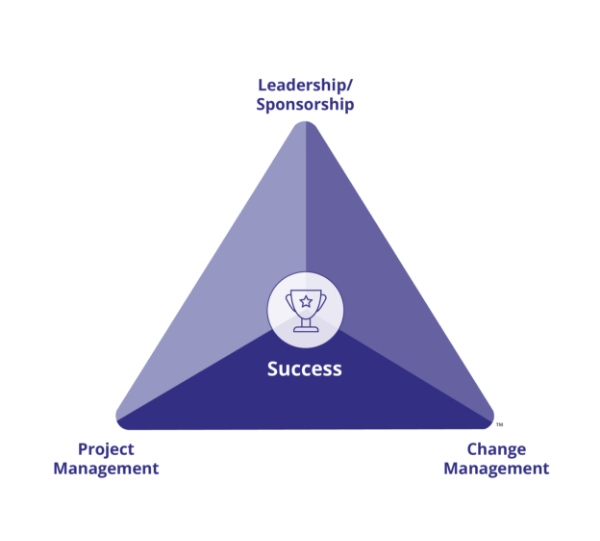How to Talk to Executives and Sponsors About Change Management

4 Mins
Updated: March 2, 2024
Published: June 3, 2020

When I chat with participants at our Change Management Certification Programs, they often ask me how to effectively engage executives in discussions about change management. This is a common challenge for change practitioners and change leads. Because I also engage with executives on the topic of change management, my understanding of the executive leader perspective may offer helpful insights.
Change Management
Through the Executive Lens
I regularly speak at company events, usually for single organizations rather than public groups, and primarily to audiences comprising senior managers, directors, vice presidents and C-level leaders. In the past two years alone, I have delivered talks to more than 1,500 leaders.
I always start a presentation to leaders asking, “How many of you feel you have a good understanding of what change management is or could provide a definition?” Invariably, more than 50 percent of the hands go up. I follow that quickly with, “For those who raised your hands, take a look around at your peers with their hands raised, and tell me if you feel your definition or understanding would be consistent with theirs.” Most hands go down.
This is surprising and revealing. Although change management is part of the corporate lexicon, and leaders know of or have some exposure to it, they are not comfortable with their organization’s understanding of it. This leads me to believe that change management conversations among leaders at the start of a project or an initiative usually do not start with a common understanding of change management.
Although I am in the business of change management, I acknowledge that the definition of change management is “a bit fuzzy around the edges.” It is difficult to nail down. My hope is that the tips below will help you change the conversation in your organization, so you can increase understanding among your leaders and begin to speak a common language about change.
1. Speak the language of executives
Remember the ADKAR Model. You need to build Awareness and Desire for change management with your executives before providing them with Knowledge about technical aspects of what they need to do. Desire for executives is based on the familiar “what’s in it for me,” except that “me” is really “the company” for this group.
Therefore, it’s important to align your language with the language of your audience. Think about language as currency. What language holds value in your organization? Generate discussions with executives in the language that holds value to them.
For example, if discussions around risk are central in your organization—risk assessment, risk management, risk mitigation or similar—you want to position change management within the risk management stream. The reality is that when you work with a Project Change Triangle (PCT) or Risk Assessment or even an ADKAR Business Assessment, you are working to quantify the risk of impacted users not adopting the prescribed change. Quantifying the risk enables you to build the appropriately scaled change management plans. Presenting change management in the context of risk mitigation enables you to build out a series of strategies to mitigate the risk of impacted employee groups failing to adopt a change. For executives with an eye on risk, this speaks to them in their own language. It associates the change management activities with their definition of value.
Prosci Risk Assessment Grid
.png?width=600&name=Risk-Grid-Blog%20(1).png)
Let’s try a different spin. Perhaps your organization is all about speed, and terms like innovation, agility and time-to-market rule the day. In that case, you can position change management as change acceleration or benefits acceleration. The beautiful thing about this is that all the same assessments and activities you position as risk mitigation can easily be positioned as activities to drive change acceleration. Think of it as an economical re-use of the same language.
If you ask executives if they prefer to reap project benefits in 7 to 8 months or 2 to 3 months, we know the answer. But what about executives who believe project benefits are inevitable and that employees will fundamentally “get on board” and make the change the business prescribes? The jury is out on whether that will actually happen. But even if it does, research supports the fact that change management helps them adopt the change faster. Positioning your change activities as a key enabler to drive accelerated benefits will resonate with your executives.
2. Compare change management to project management
Another approach is to compare change management to something they are more familiar with. The most common example is project management. As an organizational discipline, project management is generally more mature than change management and executives have likely been around it for some time.
Executives will tend to liken change management with project management and expect it to act similarly within the organization. With project management, executives know their role in the project, which is to identify what they want, when they want it, how much they are prepared to spend, and to revisit the inherent trade-offs throughout the project. The ultimate project management measurement is to be on scope, on time and on budget.
Executives also see project management within a tightly controlled ecosystem. Sure, projects get input from users and business process owners, but the project does not rely on daily operational management to drive the on-scope, on-time, on-budget result. If the project team is focused on these elements, who carries the ball for the “on-adoption” element? The answer, of course, is change management.
Again, be sure to spell it out for executives in terms that resonate with them. To do that, place change management activity clearly within the operational management aspect of the business:
While the project team prepares the solution for the organization,
the change team prepares the organization for the solution.
Similarly, if the project management team operates in an isolated fashion “over there,” then the change team operates, naturally, everywhere else. The change management ecosystem comprises all the operational teams impacted by whatever this project team delivers. Although their activities are connected, change management activities happen everywhere but within the project team.
It is important to continually articulate this change management mantra—the project is not the change. Implementing ERP or CRM or redesigning the organizational structure is the project, but that is not the change.
3. Engage your Sponsor in change activities
The best way to drive home the change management mantra is to have your Sponsor participate in some of the assessment activity, ideally the Prosci PCT Assessment and Risk Assessment. Although quantifying risk through the process of measuring change attributes matters, the true value of these assessments is in the conversations they generate. Have your Sponsor participate. Looking at risk through the change management lens will be revealing and create buy-in for the change management activities the assessment results inform.

The Prosci Change Triangle (PCT) Model
The Executive's ADKAR Journey
When an executive decides to move forward on a key new initiative, they arrived at that conclusion by putting themselves through the ADKAR journey. They were not likely conscious of it, but they socialized the idea to drive Awareness and Desire, built Knowledge and Ability by gathering and understanding key data and information, and continued Reinforcing the idea right up to the day of the announcement. And it took several months of planning and strategizing to make the decision. Now the executive needs to understand that the rest of the organization needs to go through that process to ensure full adoption and realize project benefits. When you discuss change management in terms of their own experience, it’s easy for executives to see why the ADKAR journey matters to everyone impacted by change.


